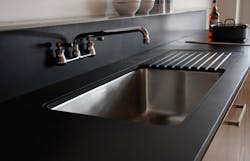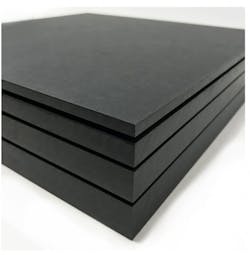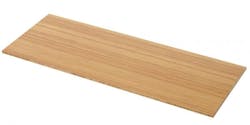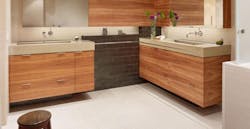Need to Find Affordable Countertops? These Six Strategies Will Help
Finding attractive and durable countertops is easy when you have the money, but things get more difficult when the budget is tight.
For pros, as well as their clients and buyers, it’s important to balance cost with durability. In most cases, the more durable and low maintenance the surface—granite, quartz, soapstone—the pricier the material. (The rare case, of course, is various types marbles, such as Carrerra, that are prone to stains and need to be sealed but can be very expensive). Affordable options, such as ceramic tiles, wood, and laminate, tend to have maintenance issues or practicality issues.
That’s why choosing countertops is tricky. But it’s very important because of the importance of the countertop. A pivotal part of the design, the kitchen countertop is perhaps the most recognizable element after the cabinetry, and it’s among the most expensive in that space, too. Not only is it literally the center of attention, it performs an important functional role as well.
[ Read More: 5 Eco-Friendly Countertops That Add Beauty With a Sustainable Flair ]
Richlite paper-based surfacing
“The countertop is an essential component of the kitchen,” Bryan Sebring writes on Sebring Design Build. “It is where all the action takes place. But more than that, the countertop is the foundation of kitchen décor when doing a kitchen renovation. It bares the burden of setting the tone and feel of the space.”
Good countertop options are easy to find when the budget is healthy. And choices are a plenty. At the moment, quartz is the hottest thing on the market. Made from a combination of 93% natural quartz, resin, and colorants, quartz can be fabricated to look like almost anything—soapstone, concrete, metal, marble, and even slate. But the beauty of quartz is that it also comes in a wide variety of colors, and manufacturers can add aggregates to make the surface truly sparkle.
In 2016, Home Innovation Research Labs, an independent subsidiary of the National Association of Home Builders, conducted a survey of more than 110,000 U.S. and Canadian households, and quartz was the preferred surfacing among 17% of respondents. This number was 8% in 2011.
But even with quartz's rapid growth, stone, specifically granite, is still the king of all surfaces. It accounts for about 40% of home countertop replacements in 2016, says Home Innovation.
Granite isn’t the only option though. Consumers can choose from soapstone, quartzite, volcanic stone, exotic marbles, solid surface, metals, exotic hardwoods, sintered stone, and on and on.
But all of these options are pricey. How do you fit out your next kitchen and bath with a countertop that not only looks good but also won’t break the bank? We’ve done some research and found some strategies to help you get the job done:
1. Think Outside the Box
Don’t rule anything out. Yes, there is a wide range of material options on the market. Forget about them. Because your budget is small, you can’t afford those products, so it’s time to get creative. Of course, your buyers and clients can opt for faithful, affordable standby options such as laminate or ceramic tile, but not everyone likes the look (or feel) of laminate, and kitchen countertops with grout lines (though affordable) are not a great idea in 2020. Open your mind to alternatives (see tip #2 below).
2. Explore Alternatives
The countertop category has other options other than stone or quartz. How about paper-based composites? They go by either Richlite or PaperStone, and they can be fabricated with regular woodworking tools. Paper-based surfacing was originally developed for industrial purposes, but makes a durable surfacing option. Composed of approximately 65% recycled paper content and 35% resin, the product has a mottled appearance but takes on different look when you apply mineral oil or beeswax. What about bamboo? Or have you heard about TorZo Surfaces, an architectural surface that is manufactured from recycled or salvage agricultural, textile, and forestry products. The point there options out there. Tip: Some of of these materials may require more upkeep than your clients are used to, so make sure to explain this.
3. Don’t Forget Wood
Wood is the original solid surface. Exotic woods, such as mahogany, teak, or walnut, are pricey, but there are other species that can make for a beautiful and affordable island in a kitchen. French oak, maple, or even acacia makes for attractive top. Wood requires routine maintenance and is not ideal around wet areas, but it is very attractive and can easily be repaired with sanding. Today, manufacturers are also producing countertops from bamboo, which is ideal for islands, bar tops, or workstations near the kitchen.
[ Read More: 7 THINGS YOU SHOULD KNOW BEFORE CHOOSING CONCRETE COUNTERTOPS ]
Ikea Tolken bamboo countertop
4. Concrete is Still a Good Option
As we reported earlier this year, concrete remains a desirable option on the periphery of the mainstream, but it offers flexibility and a creative potential that other materials simply cannot provide. Plus, the material has gone high-tech—sort of. Gone are the days when you have to pour heavy traditional concrete. You can now pour thinner material embedded with fiberglass for strength. And you can even spray it into molds.
One of the great things about concrete is that trade contractors and remodelers can learn to fabricate concrete countertops in-house for your clients and make it a potential revenue-generating enterprise. Places such as the Concreteexchange.com and ConcreteNetwork.com offer training, concrete design advice, fabrication, and materials for those who want to learn the process.
Still, concrete is not for everyone. It requires regular maintenance and is sensitive to stains from such items as lemon juice, oils, and wine. Depending on your buyer or client, that may not be a dealbreaker. Ask them.
A San Francicso high-rise bathroom by Futung Cheng. Courtesy the ConcreteNetwork.com
5. If They/You Must Have Stone...
If you or your client insist on stone, you still have some options, but you may have to work harder to find a solution. Big box home improvement stores offer some options, but the options are usually limited and may not be the most attractive. A stone yard is your best bet for affordable options, particularly for bathroom vanities. As for the “remnant options?"
“Remnant granite is a term that refers to the leftovers stone manufacturers are left with after cutting slabs for large countertops, tiling, and other jobs,” the home improvement referral site HomeAdvisor says. “That being the case, this isn’t a material that is suitable if you’re looking for a huge solid slab kitchen countertop. If you’re in the market for something smaller, however, granite leftovers can be a very cost effective way to add class and a top grade material to many common home improvements.”
Outfits such as RE Marble and Granite in New Hampshire and EuroStoneCraft in Herndon, Va., offer stone tops at steeply discounted prices. EuroStoneCraft even offers vanity tops online at StoneRemnantsOnline.com
Walnut island top by eButcherBlock.com
6. Scour the Web
This goes without saying, but the web is still a great place to source building products. Buying from local suppliers is always the preferred method; if that fails, though, the web provides a wide range of sources that can be ideal in certain situations. Outlets such as Green Countertops Direct, Overstock.com, eButcherBlock.com, and SolidSurface.com offer countertops at reduced prices.
[Related: WOOD COUNTERTOPS ARE GREAT BUT REQUIRE SPECIAL MAINTENANCE ]
Concrete kitchen countertop. Courtesy The Home Depot





